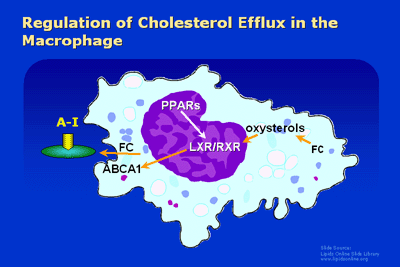HDL and reverse cholesterol transport
Last reviewed 03/2021
- the protective role of HDL against atherosclerosis is believed to be due in part to the process of reverse cholesterol transport, whereby excess free cholesterol (FC) is removed from cells in peripheral tissues, such as macrophages within the arterial wall, and returned to the liver for excretion in the bile
- hydrolysis of intracellular cholesteryl ester (CE) stores generates FC. Several key molecules play a role in reverse cholesterol transport, including ATP-binding cassette protein A1 (ABCA1), lecithin:cholesterol acyltransferase (LCAT), and scavenger receptor class-B, type I (SR-BI). There is evidence from animal models that that compromised ABCA1 activity leads to accelerated and early atherogenesis (1). Promotion of reverse cholesterol transport could in theory help reduce atherosclerosis
Figure 1: HDL and reverse cholesterol transport (from www.lipidsonline.org)

- regulation of cholesterol efflux in the macrophage
- the cellular transporter ABCA1 is a critical protein that transports excess free cholesterol (FC) out of the cell to an acceptor, lipid-poor apo A-I
- ABCA1 gene transcription is regulated by the nuclear receptor heterodimer liver X receptor/retinoid X receptor (LXR/RXR). Cellular oxysterols appear to be one of the endogenous ligands for LXR and promote the transcription of ABCA1. Oxysterols are generated from free cholesterol. The transcription of the LXR is also influenced by both peroxisome proliferator-activated receptor alpha (PPAR-alpha) and PPAR-gamma
Figure 2: Regulation of cholesterol efflux in the macrophage (from www.lipidsonline.org)

Pharmacologic manipulation of cholesterol efflux
- There is a great deal of interest in the pharmacologic manipulation of cholesterol efflux in the macrophage. Both fibrates, which are PPAR-alpha agonists, and thiazolidinediones (TZDs), or glitazones, which are PPAR-gamma agonists, are already available and may raise HDL and reduce atherosclerosis in part through this mechanism. New agents are also being developed that target the PPARs. Also agents are being developed that target LXR or RXR as potential strategies for upregulating ABCA1 and promoting cholesterol efflux
Reference: